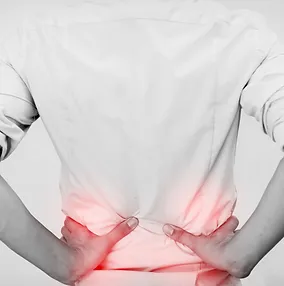Sciatica

Many people who suffer from back pain often refer to their pain as sciatica. However, sciatica is actually a specific type of back and leg pain that can be incorrectly labeled as the root cause of back pain. Sciatica is defined by a very specific set of symptoms. Here’s what you need to know about sciatica pain, causes, and treatment.
Do I have sciatica?
As mentioned above, sciatica is a type of pain that stems from irritation or damage to the sciatic nerve. The sciatic nerve is the longest, widest nerve in your body. It originates in the lumbar spine, crosses the back of the buttocks, travels down the side of the hip, and all the way to the top of each foot.
Any irritation or damage along the length of this nerve can cause sciatica symptoms.
The most common include:
-
Weakness
-
Numbness in the leg or foot
-
Pins and needles feeling anywhere along the nerve path
-
Burning pain
-
Stabbing pain that worsens when you sneeze or cough
-
Shooting pain that makes prolonged sitting or standing impossible
-
Radiating pain that originates from the lumbar spine
You’ll typically only feel sciatica symptoms on one side of your body. The symptoms above are most common, but if your pain suddenly increases or you lose control of your bowels or bladder, it important to get immediate, emergency medical attention.
Compression of or damage to the sciatic nerve causes the set of symptoms known as sciatica. This damage can occur along the length of the nerve but most commonly originates in the lumbar spine. There are several lower back conditions, however, that can lead to this type of back and leg pain.
-
Herniated or bulging discs
This is the most common cause of sciatica. An intervertebral disc either bulges between the vertebrae and presses on the nerve, or the disc ruptures completely and the vertebrae itself applies pressure. It can occur in all areas of the spine, but most especially in the lumbar spine.
-
Piriformis syndrome
The piriformis muscle is located deep in the gluteus maximus and can spasm or become irritated due to injury or strain.
When this happens, it presses on the sciatic nerve that passes underneath it, causing pain.
-
Spinal stenosis
Spinal stenosis is a condition where the spinal column begins to narrow. Although it can occur in the cervical vertebrae (those in your neck) as well, sciatica only accompanies lumbar spinal stenosis.
-
Spondylolisthesis
Spondylolisthesis occurs when one vertebra slips over the top of the other. This can narrow the opening through which the sciatic nerve exits.
-
Degenerative disc disease
Degenerative disc disease occurs largely due to age. The intervertebral discs can become brittle and less supportive and may eventually bulge and herniate.
In addition to trauma or injury (i.e., a car accident or sports injury), herniated lumbar disc causes are most often associated with normal, age-related wear and tear that results in gradual disc degeneration. Degenerative disc disease is an accelerated version of this wear and tear. It can occur in younger patients, but most often occurs in patients over the age of 60.
There are risk factors that can increase your chances of developing herniated discs (or that accelerate the wear on your spine in general). These include:
-
Occupational hazards: Jobs that require repetitive heavy lifting or twisting in the spine increase the chance of injury and the pace of wear
-
Weight: Patients who are overweight have additional stress on all of their joints, including the ones in their spine
-
Prolonged periods of sitting: Remaining seated for long periods of time can place extra pressure on your lumbar spine
-
Smoking: Smoking decreases oxygen in the body and can accelerate disc degeneration
-
Gender: Men between the ages of 20 and 50 are most likely to herniate a disc for reasons other than normal wear and tear
Getting plenty of exercise, quitting smoking, and maintaining a healthy body weight are all good ways to decrease your chances of experiencing a lumbar herniated disc with radiculopathy.
There are some common risk factors that make a person more prone to sciatica. Age is a common risk factor, as discs deteriorate and gravity takes a toll on the spine. Patients who are overweight also have more stress on their spine, exacerbating any other risk factors. Other obesity-related health conditions also increase a person’s chances of developing sciatic pain. This may include a diagnosis of Type 1 and Type 2 diabetes, as well as behavioral risk factors like prolonged sitting and lack of exercise.
The type of work you do can also increase your risk of sciatica. Work that requires you to lift heavy loads, especially along with twisting or making these movements repetitively, increases the stress and strain on your spine and can eventually cause damage.
At North Texas Neurosurgical Consultants, our approach to sciatica treatment is comprehensive and starts with lifestyle interventions to improve pain.
These may include things like adding more exercise, stopping smoking, and using dietary interventions to support a healthy weight. We consider physical therapy another excellent option for some patients to bring more space to the spine and movement to the body. In these patients, building the back and core muscles to support the spine can gradually decrease the pressure on their sciatic nerve, relieving pain.
If patients do not experience relief with these non-invasive sciatica treatment options, injections to relieve pain may be in order. These injections can also be used as a diagnostic tool. If the injection relieves pain, this gives us a better idea of where the nerve pain is starting from.
Finally, in cases where non-invasive and minimally-invasive techniques have failed to provide relief, we offer a variety of surgical techniques that can help patients with severe pain that affects their overall quality of life.
SPINAL CORD DECOMPRESSION SURGERY
Spinal cord decompression surgery creates space between the vertebrae. When an intervertebral disc is injured or otherwise damaged, the resulting compression of the vertebrae presses on the nerves and can lead to sciatica pain.
Opening up this space (and potentially performing spinal fusion for stability) relieves painful pressure on the sciatic nerve.
POSTERIOR LUMBAR INTERBODY FUSION
Posterior lumbar interbody fusion is a procedure that addresses stubborn back pain involving the intervertebral discs.
During an interbody fusion procedure, your surgeon removes the injured or dysfunctional disc, gently moving the nerves in that space to the side. The disc is replaced by a bone graft and a metal cage that is further stabilized with screws or rods. A posterior lumbar interbody fusion is performed with a smaller, less invasive incision in the back of the body.
LUMBAR LAMINECTOMY WITH NERVE ROOT DECOMPRESSION
The back of each vertebra has lamina, or connective tissue that covers and protects your spinal canal. A lumbar laminectomy removes the lamina to relieve pressure on the nerves and the spinal cord. This decompression can ease chronic, excruciating back pain where other more conservative treatments have been unsuccessful. This may be accompanied by a spinal fusion when appropriate.
How We Can Help.

Approach
Sciatica pain can be debilitating, creating painful challenges in everyday life. If you are ready to get help for your pain, come see us at North Texas Neurosurgical Consultants. Dr. Rosenstein and the rest of the team are based in Dallas/Fort Worth area but welcome patients from all over Texas.
If you have additional questions, get in touch with the team at North Texas Neurosurgical Consultants for more information.
